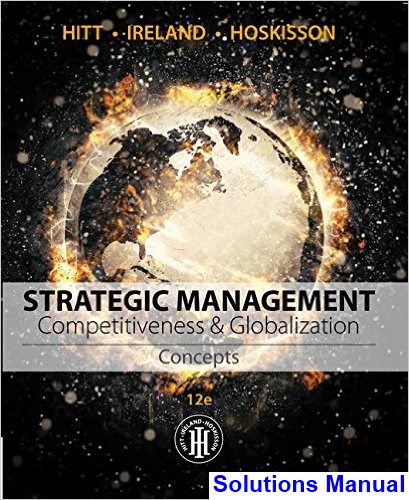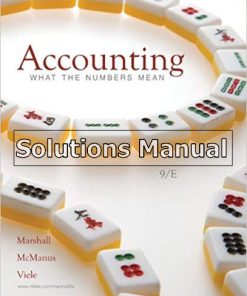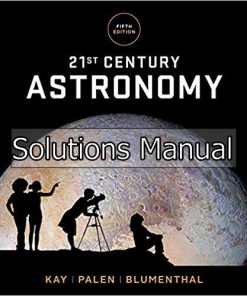Strategic Management Concepts and Cases Competitiveness and Globalization 12th Edition Hitt Solutions Manual
$26.50$50.00 (-47%)
Strategic Management Concepts and Cases Competitiveness and Globalization 12th Edition Hitt Solutions Manual.
You may also like
This is completed downloadable of Strategic Management Concepts and Cases Competitiveness and Globalization 12th Edition Hitt Solutions Manual

Product Details:
- ISBN-10 : 1305502140
- ISBN-13 : 978-1305502147
- Author:
Examine strategic management with the market-leading text that sets the standard for the most intellectually rich, practical analysis of strategic management. Written by respected experts Hitt, Ireland, and Hoskisson, the 12th edition of STRATEGIC MANAGEMENT is steeped in cutting-edge research featuring more than 500 emerging and leading companies, and reveals trends you can implement immediately to succeed in your field. You’ll discover how to integrate the classic industrial organization model with a resource-based view of the firm to give you a complete understanding of how today’s businesses use strategic management to establish competitive advantages and create value for stakeholders in the global marketplace. The freshly reimagined MindTap learning solution provides you with real-world activities that will prepare you to excel as a leader and outperform rivals.
Table of Content:
- Part 1: Strategic Management Inputs
- Chapter 1: Strategic Management and Strategic Competitiveness
- Opening Case: Alibaba: An Online Colossus in China Goes Global
- 1-1 The Competitive Landscape
- 1-1a The Global Economy
- 1-1b Technology and Technological Changes
- Strategic Focus
- 1-2 The I/O Model of Above-Average Returns
- 1-3 The Resource-Based Model of Above-Average Returns
- 1-4 Vision and Mission
- 1-4a Vision
- 1-4b Mission
- 1-5 Stakeholders
- Strategic Focus
- 1-5a Classifications of Stakeholders
- 1-6 Strategic Leaders
- 1-6a The Work of Effective Strategic Leaders
- 1-7 The Strategic Management Process
- Summary
- Key Terms
- Review Questions
- Mini-Case
- Notes
- Chapter 2: The External Environment: Opportunities, Threats, Industry Competition, and Competitor An
- Opening Case: Are There Cracks in The Golden Arches?
- 2-1 The General, Industry, and Competitor Environments
- 2-2 External Environmental Analysis
- 2-2a Scanning
- 2-2b Monitoring
- 2-2c Forecasting
- 2-2d Assessing
- 2-3 Segments of the General Environment
- 2-3a The Demographic Segment
- 2-3b The Economic Segment
- 2-3c The Political/Legal Segment
- 2-3d The Sociocultural Segment
- 2-3e The Technological Segment
- 2-3f The Global Segment
- 2-3g The Sustainable Physical Environment Segment
- Strategic Focus
- 2-4 Industry Environment Analysis
- 2-4a Threat of New Entrants
- 2-4b Bargaining Power of Suppliers
- 2-4c Bargaining Power of Buyers
- 2-4d Threat of Substitute Products
- 2-4e Intensity of Rivalry among Competitors
- 2-5 Interpreting Industry Analyses
- 2-6 Strategic Groups
- Strategic Focus
- 2-7 Competitor Analysis
- 2-8 Ethical Considerations
- Summary
- Key Terms
- Review Questions
- Mini-Case
- Notes
- Chapter 3: The Internal Organization: Resources, Capabilities, Core Competencies, and Competitive Ad
- Opening Case: Data Analytics, Large Pharmaceutical Companies, and Core Competencies: A Brave New Wor
- 3-1 Analyzing the Internal Organization
- 3-1a The Context of Internal Analysis
- 3-1b Creating Value
- 3-1c The Challenge of Analyzing the Internal Organization
- 3-2 Resources, Capabilities, and Core Competencies
- 3-2a Resources
- Strategic Focus
- 3-2b Capabilities
- 3-2c Core Competencies
- 3-3 Building Core Competencies
- 3-3a The Four Criteria of Sustainable Competitive Advantage
- 3-3b Value Chain Analysis
- 3-4 Outsourcing
- 3-5 Competencies, Strengths, Weaknesses, and Strategic Decisions
- Strategic Focus
- Summary
- Key Terms
- Review Questions
- Mini-Case
- Notes
- Part 2: Strategic Actions: Strategy Formulation
- Chapter 4: Business-Level Strategy
- Opening Case: Hain Celestial Group: A Firm Focused on “Organic” Differentiation
- 4-1 Customers: Their Relationship with Business-Level Strategies
- 4-1a Effectively Managing Relationships with Customers
- 4-1b Reach, Richness, and Affiliation
- 4-1c Who: Determining the Customers to Serve
- 4-1d What: Determining Which Customer Needs to Satisfy
- 4-1e How: Determining Core Competencies Necessary to Satisfy Customer Needs
- 4-2 The Purpose of a Business-Level Strategy
- 4-3 Types of Business-Level Strategies
- 4-3a Cost Leadership Strategy
- 4-3b Differentiation Strategy
- Strategic Focus
- 4-3c Focus Strategies
- 4-3d Integrated Cost Leadership/Differentiation Strategy
- Strategic Focus
- Summary
- Key Terms
- Review Questions
- Mini-Case
- Notes
- Chapter 5: Competitive Rivalry and Competitive Dynamics
- Opening Case: Does Google Have Competition? Dynamics of the High Technology Markets
- 5-1 A Model of Competitive Rivalry
- 5-2 Competitor Analysis
- 5-2a Market Commonality
- 5-2b Resource Similarity
- Strategic Focus
- 5-3 Drivers of Competitive Behavior
- 5-4 Competitive Rivalry
- 5-4a Strategic and Tactical Actions
- 5-5 Likelihood of Attack
- 5-5a First-Mover Benefits
- 5-5b Organizational Size
- 5-5c Quality
- 5-6 Likelihood of Response
- 5-6a Type of Competitive Action
- 5-6b Actor’s Reputation
- 5-6c Market Dependence
- 5-7 Competitive Dynamics
- 5-7a Slow-Cycle Markets
- 5-7b Fast-Cycle Markets
- 5-7c Standard-Cycle Markets
- Strategic Focus
- Summary
- Key Terms
- Review Questions
- Mini-Case
- Notes
- Chapter 6: Corporate-Level Strategy
- Opening Case: Disney Adds Value Using a Related Diversification Strategy
- 6-1 Levels of Diversification
- 6-1a Low Levels of Diversification
- 6-1b Moderate and High Levels of Diversification
- 6-2 Reasons for Diversification
- 6-3 Value-Creating Diversification: Related Constrained and Related Linked Diversification
- 6-3a Operational Relatedness: Sharing Activities
- 6-3b Corporate Relatedness: Transferring of Core Competencies
- 6-3c Market Power
- 6-3d Simultaneous Operational Relatedness and Corporate Relatedness
- 6-4 Unrelated Diversification
- 6-4a Efficient Internal Capital Market Allocation
- Strategic Focus
- 6-4b Restructuring of Assets
- 6-5 Value-Neutral Diversification: Incentives and Resources
- 6-5a Incentives to Diversify
- Strategic Focus
- 6-5b Resources and Diversification
- 6-6 Value-Reducing Diversification: Managerial Motives to Diversify
- Summary
- Key Terms
- Review Questions
- Mini-Case
- Notes
- Chapter 7: Merger and Acquisition Strategies
- Opening Case: Mergers and Acquisitions: Prominent Strategies for Firms Seeking to Enhance Their Perf
- 7-1 The Popularity of Merger and Acquisition Strategies
- 7-1a Mergers, Acquisitions, and Takeovers: What Are the Differences?
- 7-2 Reasons for Acquisitions
- Strategic Focus
- 7-2a Increased Market Power
- 7-2b Overcoming Entry Barriers
- Strategic Focus
- 7-2c Cost of New Product Development and Increased Speed to Market
- 7-2d Lower Risk Compared to Developing New Products
- 7-2e Increased Diversification
- 7-2f Reshaping the Firm’s Competitive Scope
- 7-2g Learning and Developing New Capabilities
- 7-3 Problems in Achieving Acquisition Success
- 7-3a Integration Difficulties
- 7-3b Inadequate Evaluation of Target
- 7-3c Large or Extraordinary Debt
- 7-3d Inability to Achieve Synergy
- 7-3e Too Much Diversification
- 7-3f Managers Overly Focused on Acquisitions
- 7-3g Too Large
- 7-4 Effective Acquisitions
- 7-5 Restructuring
- 7-5a Downsizing
- 7-5b Downscoping
- 7-5c Leveraged Buyouts
- 7-5d Restructuring Outcomes
- Summary
- Key Terms
- Review Questions
- Mini-Case
- Notes
- Chapter 8: International Strategy
- Opening Case: Netflix Ignites Growth Through International Expansion, But Such Growth Also Fires Up
- 8-1 Identifying International Opportunities
- 8-1a Incentives to Use International Strategy
- 8-1b Three Basic Benefits of International Strategy
- 8-2 International Strategies
- 8-2a International Business-Level Strategy
- 8-2b International Corporate-Level Strategy
- Strategic Focus
- 8-3 Environmental Trends
- 8-3a Liability of Foreignness
- 8-3b Regionalization
- 8-4 Choice of International Entry Mode
- 8-4a Exporting
- 8-4b Licensing
- 8-4c Strategic Alliances
- 8-4d Acquisitions
- 8-4e New Wholly Owned Subsidiary
- 8-4f Dynamics of Mode of Entry
- 8-5 Risks in an International Environment
- 8-5a Political Risks
- 8-5b Economic Risks
- Strategic Focus
- 8-6 Strategic Competitiveness Outcomes
- 8-6a International Diversification and Returns
- 8-6b Enhanced Innovation
- 8-7 The Challenge of International Strategies
- 8-7a Complexity of Managing International Strategies
- 8-7b Limits to International Expansion
- Summary
- Key Terms
- Review Questions
- Mini-Case
- Notes
- Chapter 9: Cooperative Strategy
- Opening Case: Google, Intel, and Tag Heuer: Collaborating to Produce a Smartwatch
- 9-1 Strategic Alliances as a Primary Type of Cooperative Strategy
- 9-1a Types of Major Strategic Alliances
- 9-1b Reasons Firms Develop Strategic Alliances
- 9-2 Business-Level Cooperative Strategy
- 9-2a Complementary Strategic Alliances
- 9-2b Competition Response Strategy
- 9-2c Uncertainty-Reducing Strategy
- 9-2d Competition-Reducing Strategy
- Strategic Focus
- 9-2e Assessing Business-Level Cooperative Strategies
- 9-3 Corporate-Level Cooperative Strategy
- 9-3a Diversifying Strategic Alliance
- 9-3b Synergistic Strategic Alliance
- 9-3c Franchising
- 9-3d Assessing Corporate-Level Cooperative Strategies
- 9-4 International Cooperative Strategy
- 9-5 Network Cooperative Strategy
- 9-5a Alliance Network Types
- 9-6 Competitive Risks with Cooperative Strategies
- Strategic Focus
- 9-7 Managing Cooperative Strategies
- Summary
- Key Terms
- Review Questions
- Mini-Case
- Notes
- Part 3: Strategic Actions: Strategy Implementation
- Chapter 10: Corporate Governance
- Opening Case: The Corporate Raiders of the 1980s Have Become the Activist Shareholders of Today
- 10-1 Separation of Ownership and Managerial Control
- 10-1a Agency Relationships
- 10-1b Product Diversification as an Example of an Agency Problem
- 10-1c Agency Costs and Governance Mechanisms
- 10-2 Ownership Concentration
- 10-2a The Increasing Influence of Institutional Owners
- 10-3 Board of Directors
- 10-3a Enhancing the Effectiveness of the Board of Directors
- 10-3b Executive Compensation
- 10-3c The Effectiveness of Executive Compensation
- Strategic Focus
- 10-4 Market for Corporate Control
- 10-4a Managerial Defense Tactics
- 10-5 International Corporate Governance
- 10-5a Corporate Governance in Germany and Japan
- Strategic Focus
- 10-5b Corporate Governance in China
- 10-6 Governance Mechanisms and Ethical Behavior
- Summary
- Key Terms
- Review Questions
- Mini-Case
- Notes
- Chapter 11: Organizational Structure and Controls
- Opening Case: Luxottica’s Dual Ceo Structure: A Key to Long Term Success or a Cause for Concern?
- 11-1 Organizational Structure and Controls
- 11-1a Organizational Structure
- Strategic Focus
- 11-1b Organizational Controls
- 11-2 Relationships between Strategy and Structure
- 11-3 Evolutionary Patterns of Strategy and Organizational Structure
- 11-3a Simple Structure
- 11-3b Functional Structure
- 11-3c Multidivisional Structure
- 11-3d Matches between Business-Level Strategies and the Functional Structure
- 11-3e Matches between Corporate-Level Strategies and the Multidivisional Structure
- Strategic Focus
- 11-3f Matches between International Strategies and Worldwide Structure
- 11-3g Matches between Cooperative Strategies and Network Structures
- 11-4 Implementing Business-Level Cooperative Strategies
- 11-5 Implementing Corporate-Level Cooperative Strategies
- 11-6 Implementing International Cooperative Strategies
- Summary
- Key Terms
- Review Questions
- Mini-Case
- Notes
- Chapter 12: Strategic Leadership
- Opening Case: Can You Follow an Icon and Succeed? Apple and Tim Cook After Steve Jobs
- 12-1 Strategic Leadership and Style
- 12-2 The Role of Top-Level Managers
- 12-2a Top Management Teams
- 12-3 Managerial Succession
- Strategic Focus
- 12-4 Key Strategic Leadership Actions
- 12-4a Determining Strategic Direction
- 12-4b Effectively Managing the Firm’s Resource Portfolio
- Strategic Focus
- 12-4c Sustaining an Effective Organizational Culture
- 12-4d Emphasizing Ethical Practices
- 12-4e Establishing Balanced Organizational Controls
- Summary
- Key Terms
- Review Questions
- Mini-Case
- Notes
- Chapter 13: Strategic Entrepreneurship
- Opening Case: Entrepreneurial Fervor and Innovation Drive Disney’s Success
- 13-1 Entrepreneurship and Entrepreneurial Opportunities
- 13-2 Innovation
- 13-3 Entrepreneurs
- 13-4 International Entrepreneurship
- 13-5 Internal Innovation
- 13-5a Incremental and Novel Innovation
- Strategic Focus
- 13-5b Autonomous Strategic Behavior
- 13-5c Induced Strategic Behavior
- 13-6 Implementing Internal Innovations
- 13-6a Cross-Functional Product Development Teams
- 13-6b Facilitating Integration and Innovation
- 13-6c Creating Value from Internal Innovation
- 13-7 Innovation through Cooperative Strategies
- 13-8 Innovation through Acquisitions
- Strategic Focus
- 13-9 Creating Value through Strategic Entrepreneurship
- Summary
- Key Terms
- Review Questions
- Mini-Case
- Notes
- Part 4: Preparing an Effective Case Analysis
- Name Index
- Company Index
- Subject Index
People Also Search:
strategic management concepts and cases competitiveness and globalization
strategic management concepts and cases competitiveness and globalization 12th edition
strategic management concepts and cases competitiveness and globalization hitt
strategic management concepts and cases competitiveness and globalization 12th edition hitt
strategic management concepts and cases competitiveness and globalization download scribd
strategic management concepts and cases competitiveness and globalization solution manual download pdf












